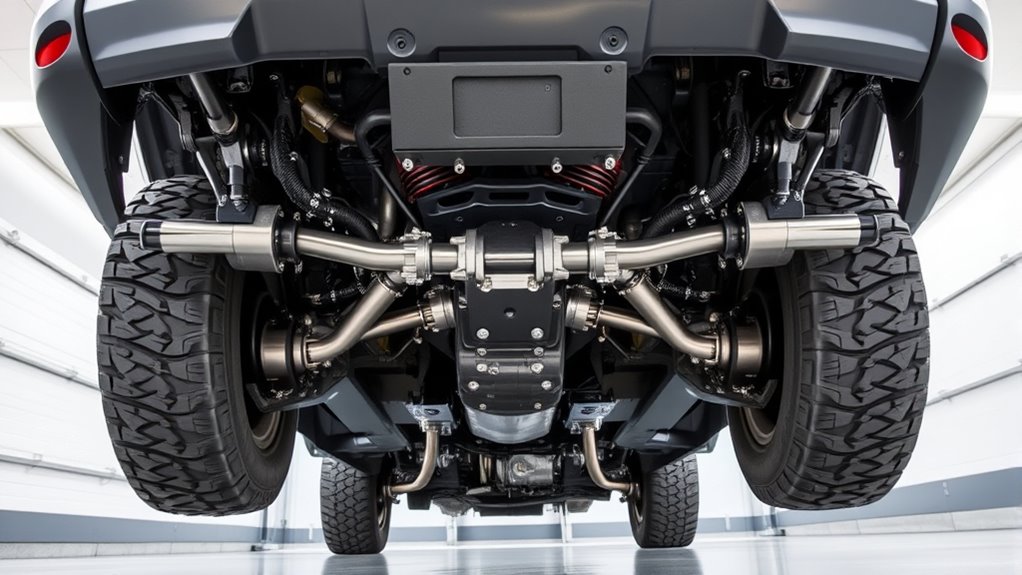Ford Transit’s AWD system actively distributes power between the front and rear wheels to improve traction, stability, and control in different conditions. It uses sensors and electronic controls to monitor road surfaces in real time and automatically engages AWD when slipping or loss of grip is detected. The system typically runs in rear-wheel drive mode but activates front wheels only when extra traction is needed. Keep exploring to learn more about how this smart system adapts to your driving needs.
Key Takeaways
- Ford Transit AWD uses sensors and electronic controls to monitor road conditions and automatically engage all four wheels when slip is detected.
- The system primarily operates in rear-wheel drive mode, activating front wheels seamlessly for added traction when needed.
- An electronically controlled clutch pack or transfer case manages torque distribution between front and rear axles dynamically.
- It engages only during challenging conditions, ensuring optimal fuel efficiency and minimal maintenance with fewer moving parts.
- The AWD system integrates with stability control and anti-lock brakes for enhanced safety and vehicle stability across various terrains.

If you’re considering a Ford Transit with all-wheel drive (AWD), understanding how it works can help you make an informed decision. AWD systems in the Transit are designed to improve traction and stability, especially when you’re driving on challenging terrains, slippery roads, or uneven surfaces.
Unlike traditional two-wheel drive vehicles, the AWD setup actively distributes power to all four wheels, giving you better control and confidence behind the wheel. Ford’s AWD system in the Transit is engineered to operate seamlessly, engaging only when necessary to optimize fuel efficiency and vehicle performance.
Unlike traditional vehicles, Ford Transit’s AWD actively improves control by engaging only when needed.
The system uses a combination of sensors and electronic controls to monitor road conditions in real time. When it detects wheel slip or loss of traction, it automatically engages the AWD system to send power to the wheels with the most grip. This process happens quickly and smoothly, often without you even noticing.
In normal driving conditions, the system primarily operates in rear-wheel drive mode to conserve fuel, engaging the front wheels only when additional traction is required. This intelligent operation ensures you’re not sacrificing efficiency for safety.
Ford’s AWD system in the Transit employs an electronically controlled clutch pack or transfer case that manages power distribution between the front and rear axles. When the sensors detect slippage, the clutch activates, transferring torque to the front wheels to stabilize the vehicle.
This process is continuous and dynamic, constantly adjusting based on driving conditions. The system also features a mode that allows you to manually select AWD, giving you more control when you’re steering through particularly difficult terrains or heavy snow.
The system’s design emphasizes simplicity and reliability, with fewer moving parts than traditional all-wheel drive setups. This not only reduces maintenance needs but also enhances durability.
Additionally, because the system is electronically managed, it integrates smoothly with other vehicle systems, such as stability control and anti-lock brakes, to provide a coordinated response to various driving challenges. This integration helps maintain vehicle balance and prevents skidding, making your driving experience safer and more predictable.
Furthermore, advances in 4K resolution and HDR support contribute to a clearer and more vibrant image quality when using projectors for home entertainment, illustrating how modern technology enhances overall user experience.
In essence, Ford’s AWD in the Transit offers a smart, responsive, and efficient way to improve traction when you need it most. It works behind the scenes, activating only when required, to give you peace of mind whether you’re carrying heavy loads, driving on slick roads, or tackling off-road adventures.
Frequently Asked Questions
Can the AWD System Be Manually Engaged or Disengaged?
No, you can’t manually engage or disengage the AWD system on your Ford Transit. It automatically activates when sensors detect wheel slip or loss of traction, ensuring best control without driver intervention.
This system is designed to operate seamlessly in the background, providing added stability and safety during challenging driving conditions. You just focus on driving, and the AWD system takes care of itself whenever it’s needed.
How Does the System Impact Fuel Efficiency?
You’ll love how the AWD system secretly boosts your fuel bill—because who needs savings when you can have enhanced traction?
It slightly reduces fuel efficiency by engaging all four wheels, especially during tough conditions.
While it’s great for slippery roads, it’s not a fuel-sipping champion.
Are There Specific Driving Conditions Where AWD Is Most Beneficial?
You’ll find AWD most beneficial when driving on slippery or uneven surfaces like snow, rain, mud, or gravel. It automatically distributes power to all wheels, giving you better traction and stability during challenging conditions.
Use AWD in these situations to maintain control, prevent slipping, and improve safety. Keep in mind that while AWD enhances performance in tough conditions, it may slightly decrease fuel efficiency compared to two-wheel drive.
What Maintenance Is Required for the AWD System?
You should regularly check your AWD system’s fluid levels and replace the transfer case fluid as recommended in your owner’s manual, usually every 30,000 to 60,000 miles.
Keep an eye on the system’s warning lights and have a professional inspect the system if you notice unusual noises, vibrations, or handling issues.
Regular maintenance guarantees your AWD system stays responsive, dependable, and ready for challenging driving conditions.
How Does Ford Transit AWD Compare to Other Van AWD Systems?
You’ll find that the Ford Transit AWD system offers a smooth, responsive experience, especially in challenging conditions. Compared to other van AWD systems, it’s known for its reliability and seamless power distribution, thanks to advanced electronic controls.
While some systems are more rugged or off-road focused, Ford’s setup balances on-road comfort and off-road capability. Overall, it’s a solid choice if you want dependable all-wheel drive without sacrificing daily drivability.
Conclusion
Understanding how the Ford Transit AWD system works helps you appreciate its durability and versatility. Did you know that AWD can improve traction and stability by distributing power to all four wheels? Imagine steering through snowy roads with confidence, knowing your vehicle adapts instantly. This advanced system isn’t just about comfort—it’s about safety, giving you peace of mind in challenging conditions. With AWD, you’re equipped to handle unexpected obstacles and reach your destination smoothly.









